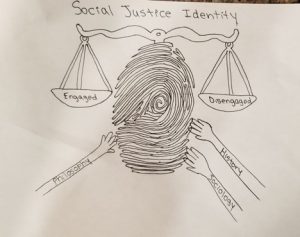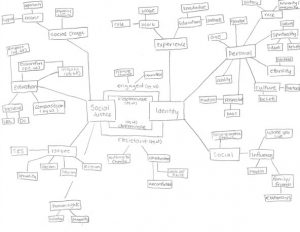The article titled “Teacher Education for Social Justice: Mapping Identity Spaces” by Mark Boylan and Ian Woosley, is about teacher identity in relation to social justice. According to the article, “social justice is an ambiguous and contested term and one that is often not defined or articulated clearly, particularly in relation to discussions of social justice in education. When used in the context of teacher education it is particularly malleable with multiple meanings” (pg 63). So, kind of hard to define. In a study done on several beginning teachers where they all took a Subject Knowledge Enhancement course relating to mathematics, they were asked about their social justice identities and where they stood in regard to social justice. The findings were that the definition of social justice differed depending on who was asked and where they were from and that most identities shifted space within their social justice identity. All interviewees were determinant before taking the course but afterwards, they were less bound to their original identity and were influenced to shift their approach. On the social justice continuum, it is essentially “for” or “against” and the middle space is where influences can shift ideas and identities. The term “striated space” refers to a very firm standpoint on social justice where they cannot be influenced. It is “sedentary space that is coded, defined, bounded and limited” (pg 65). Smooth space on the other hand is the type of identity space that the 4 interviewees were in where they could be influenced by others and possibly change their approach in some areas. They are not firm believers on one side of the continuum or the other, but rather they float somewhere in the middle. Aspects of identity and the movement between them can be conceptualized through the notion of smooth and striated space. Some other terms that came up multiple times within the paper were determinant and indeterminant. Determinate is a “view of identity that successfully describes relationships to relatively stable social justice positions” that is supported by discomfort and inquiry (pg 63). An example of this might be racism. Most people have the understanding that racism is “bad” although when it is brought up, or you are put in a position where racism is present, it can be very uncomfortable. Indeterminate are the socio-cultural accounts of identify, such as past experiences for example. Identity is a term that came up a lot as well. Identity refers to the core beliefs and values of social justice, whereas identification, or an affinity identity, is a “conscious and expressed commitment to social justice in teaching, a particular set of beliefs and practices and also identification with other teachers for social justice” (pg 63). To sum up, it is important to consider identity in teacher education for social justice. It is important to incorporate all 4 pedagogical approaches to social justice within teaching, which include inquiry, discomfort, compassion and respect. As beginning teachers, we can relate to the teachers in the study. Our standpoint on what social justice is and how we plan to implement it in the classroom may change, and most likely will, with experience.

Boylan, M., & Woosley, I. (2015). Teacher Education for Social Justice: Mapping Identity Spaces.Teaching and Teacher Education.46, 62-71.

The picture I chose to draw is a balance scale where the 2 sides represent “engaged” and “disengaged” in regard to social justice. The scale represents our personal identities, hence the fingerprint. The hands represent outside forces, including sociology, where societal influences might impact our identity; history, where past experiences may impact or influence our identity; and philosophy, where our own beliefs, religion, culture, gender, and race may play a factor in which way the scale leans. The scale may not always be in balance as our views shift over time or in different situations. Certain circumstances or influences may tip the scale in a certain direction.

Boylan, M., & Woosley, I. (2015). Teacher Education for Social Justice: Mapping Identity Spaces.Teaching and Teacher Education.46, 62-71.
Questions:
#1: What is my definition of social justice and what does this look like in the classroom?
If we asked a room full of people to describe social justice in their own words, it is most likely that the definitions would have a lot of similarities, but would all be slightly different due to each individual’s unique identity. My definition of social justice is one that focuses on enacting change to form a free and just society. A society that is both equal in some senses and equitable in others. In the classroom, I think social justice both needs to be taught, practiced and enacted. We not only have to teach students about social justice issues and solutions, we also have to practice social justice by enacting it in our classrooms and our community. If we incorporate social justice education in our classrooms, we can give students the opportunity to develop the skills and knowledge they need to enact this change in society.
#2: What is my relationship to social justice and how does my identity impact it?
This paper highlighted the fact that everyone has a relationship to social justice even if that is a “lack of awareness, a refusal to engage with, or dis-identification from, issues of social justice” (Boylan & Woodley, 2015). My relationship to social justice is one of both engagement and dis-engagement. On one hand, I feel very passionate about teaching social justice. I think teaching our future generations about social justice and how to enact change is the only way we will see our society change. Not including social justice and the issues people face in the education of students would be doing them an inservice, as they undoubtedly will be exposed to it once they leave the classroom. Students need to learn how to recognize injustice and unfairness and learn how to deal with it. On the other hand, however, teaching social justice seems like a very intimidating task. This is where the dis-engaged portion of my relationship with social justice comes in. Right now in my teacher education I feel as though I don’t have the skill set or knowledge to effectively and appropriately teach social justice. In addition, I think my identity also plays a part in my feelings of being intimidated by social justice. Coming from a privileged caucasian background, I sometimes wonder if I can effectively teach social justice or have the right to teach it. How comfortable I feel about social justice may change as I go through the teaching program and gain more experience, but the necessity in teaching social justice won’t. Regardless of how comfortable I am, social justice is something that needs to be taught and something that I will include in my classroom to the best of my ability.
Activities
Part 1:Exploring your identity (5 mins)
In this part of the activity students will explore their identity by brainstorming and create a web detailing different aspects of what makes them who they are. Some examples of topics to think about include:
- Race
- Religion
- Values
- Beliefs
- Culture
- Gender
- SES
- Background/ Upbringing
- Age
Part 2: Choose a statement
Different statements regarding social justice issues will be written around the room. In this activity, students will have to choose oneof the statements as being the most important to them. Students will discuss some of the reasons why they chose this statement with other people who also chose it. They will then share some of these reasons with the class.
The following statements were taken from: World’s Largest Lesson. (n.d.). The World is not Equal. Is that Fair?Retrieved from: http://cdn.worldslargestlesson.globalgoals.org/2016/05/The-World-Is-Not-Equal.-Is-That-Fair.pdf
Statements:
Statement 1: “I believe that equality for people of all backgrounds and ethnicities is important because all people should have the same opportunities in life and know that they will be treated fairly and with respect regardless of where they come from, the colour of their skin or what they believe” (pg. 10).
Statement 2: “I believe that equal access to education for all people regardless of who they are or where they live is important because everyone deserves the opportunity to learn and improve their lives, and it will benefit us all if everyone has basic skills and can contribute to our society and economy” (pg. 12).
Statement 3: “I believe that all human beings are all born free and equal in dignity and rights. Everyone is entitled to all rights, without discrimination of any kind. This is what it says in the Universal Declaration of Human Rights and other international human rights laws. If we all respect each other’s human rights then the world will be a much fairer place” (pg. 13).
Statement 4: “I believe that equality for people regardless of whether they have a disability or not is important because everyone should be able to go to school and to work and to move freely around their local environment. All people can contribute to our society” (pg. 11).
Part 3: This, that, or anything in between
Different scenarios or statements will be read to the class. The left side of the room will be “agree” and the right side of the room will be “disagree.” Students will be asked to position themselves based on the statement read. If students don’t fully agree or disagree they can stand somewhere in between based on their opinion.
If anyone wants to share why they chose the side (or position) they are at, there will be an opportunity for that.
Scenarios/statements:
#1: All students should be treated the same.
- What if I added that all students should be treated the same in terms gender?
- What if I added that all students should be treated the same in terms race?
- What if I added that all students should be treated the same in terms ability?
#2: Student A needs extra help getting started on all activities in the classroom. The rest of the students are usually fine getting started, but this particular activity is causing all the students to struggle getting started. The teacher automatically goes to Student A to get them started. The rest of the students feel as if they are not getting the equal amount of attention.
- Do you think this teacher did the right thing in terms of equality, why or why not?
#3: The following scenario was taken from: Smith, E. (2018). Key Issues in Education and Social Justice. Sage Publications Ltd. Retrieved from https://uk.sagepub.com/sites/default/files/upm-binaries/93444_Smith_ch_1.pdf
“Pete and Sam were both given a piece of homework by their teacher that needed to be completed by the following day. Pete went home and spent the evening researching his homework using the Internet and writing his findings up neatly and submitting his work the next morning. Sam also completed his work on time, but he scribbled it down quickly on the school bus that morning. When the marks came back Pete received a Grade A and Sam a Grade D. “ p. 14.
“Most people reading this scenario would probably argue that it is fair that Pete received a higher mark than Sam. Pete put a great deal of effort into his work- whereas Sam did not – and that effort ought to be rewarded.” p. 14.
“But what if we then found that Sam’s home life was very difficult. He had to care for his sick mother and look after his younger siblings.” p. 14.
“He had no access to the internet at home and was not able to visit his local library because he spent the evening cooking for the family and caring for the younger children. Knowledge of Sam’s circumstances might perhaps make us think differently about how he was treated.” p. 14.
